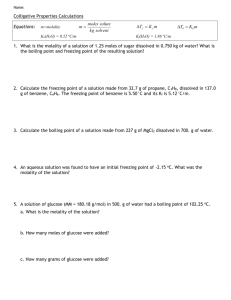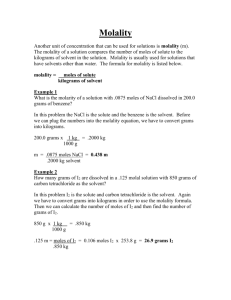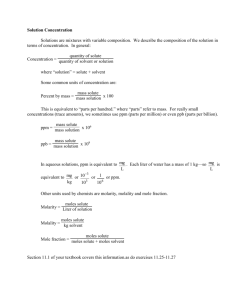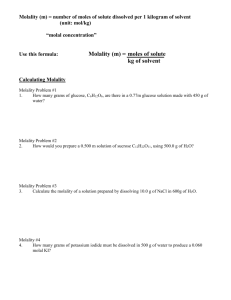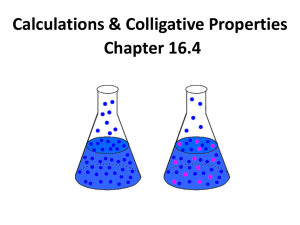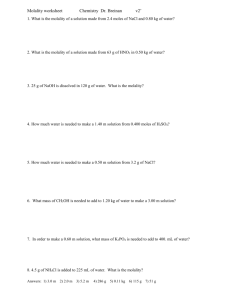Experiment 20 – Molar Mass of a Solid
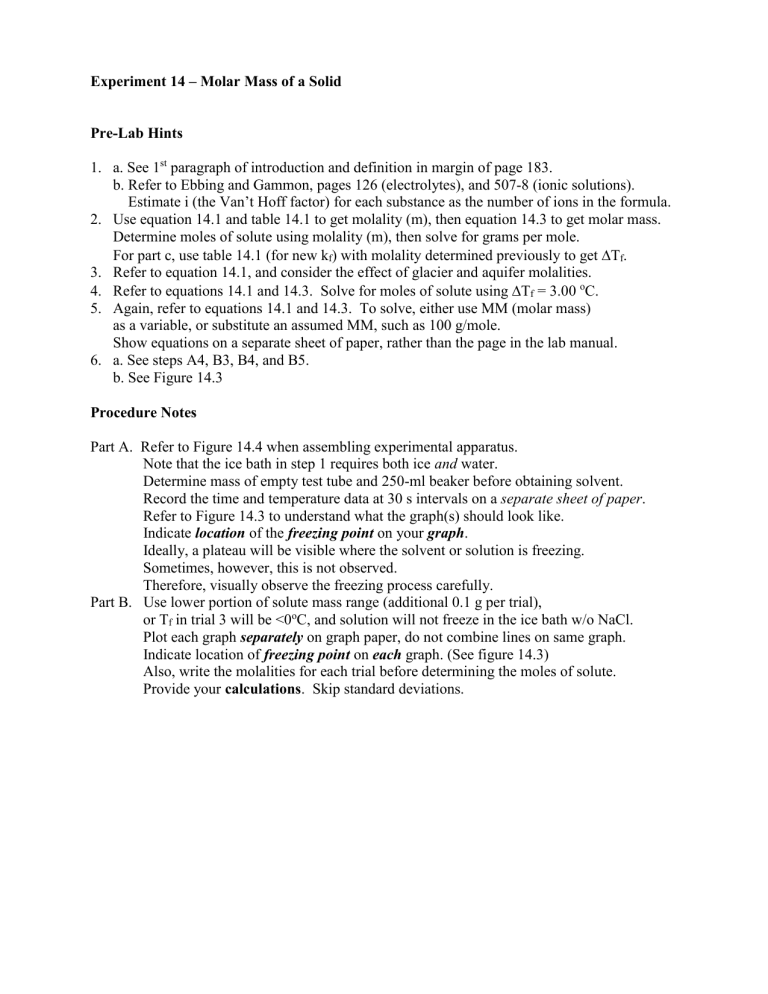
Experiment 14 – Molar Mass of a Solid
Pre-Lab Hints
1.
a. See 1 st
paragraph of introduction and definition in margin of page 183. b. Refer to Ebbing and Gammon, pages 126 (electrolytes), and 507-8 (ionic solutions).
Estimate i (the Van’t Hoff factor) for each substance as the number of ions in the formula.
2.
Use equation 14.1 and table 14.1 to get molality (m), then equation 14.3 to get molar mass.
Determine moles of solute using molality (m), then solve for grams per mole.
For part c, use table 14.1 (for new k f
) with molality determined previously to get
T f
.
3.
Refer to equation 14.1, and consider the effect of glacier and aquifer molalities.
4.
Refer to equations 14.1 and 14.3. Solve for moles of solute using
T f
= 3.00 o C.
5.
Again, refer to equations 14.1 and 14.3. To solve, either use MM (molar mass) as a variable, or substitute an assumed MM, such as 100 g/mole.
Show equations on a separate sheet of paper, rather than the page in the lab manual.
6.
a. See steps A4, B3, B4, and B5. b. See Figure 14.3
Procedure Notes
Part A. Refer to Figure 14.4 when assembling experimental apparatus.
Note that the ice bath in step 1 requires both ice and water.
Determine mass of empty test tube and 250-ml beaker before obtaining solvent.
Record the time and temperature data at 30 s intervals on a separate sheet of paper .
Refer to Figure 14.3 to understand what the graph(s) should look like.
Indicate location of the freezing point on your graph .
Ideally, a plateau will be visible where the solvent or solution is freezing.
Sometimes, however, this is not observed.
Therefore, visually observe the freezing process carefully.
Part B. Use lower portion of solute mass range (additional 0.1 g per trial),
or T f
in trial 3 will be <0 o
C, and solution will not freeze in the ice bath w/o NaCl.
Plot each graph separately on graph paper, do not combine lines on same graph.
Indicate location of freezing point on each graph. (See figure 14.3)
Also, write the molalities for each trial before determining the moles of solute.
Provide your calculations . Skip standard deviations.
Post-Lab Questions (refer to equations 14.1 and 14.3 in lab manual)
1.
Suppose you use a miscalibrated thermometer that reads 1.0 o
C higher than the actual temperature throughout the entire experiment. Consider how the miscalibration affects each temperature measurement, and then determine what happens to your
T f
values.
What would be the overall effect on your molecular weight calculations?
2.
Suppose a small amount of your solid sample is lost and does not get dissolved in the solvent.
How does this affect your number of solute moles and your molality? What happens to
T f
?
What would be the overall effect on your molecular weight calculations?
3.
Suppose a small amount of the cyclohexane vaporizes, so that there is actually less solvent mass than what you had recorded. How does this affect your molality and your
T f
?
What happens to your calculations for the number of moles?
What would be the overall effect on your molecular weight calculations?
4.
Suppose a small amount of your dissolved solute dissociates into ions.
This makes “i” (the Van’t Hoff factor) slightly larger than 1, but less than 2 (for complete dissociation). Using
T= ik f m, determine what happens to your
T f
.
How does this affect your calculations for molality, moles, and molecular weight?
(You may refer to the discussion of sodium chloride on page 183 in your lab manual, as well as to “BP/FP of Ionic Solutions” in the chapter 12 class notes.)
5.
Suppose that your solvent T f
is measured correctly, but you interpret your graphs so that the solution T f
’s values are higher than actual. How does this affect your
T f
values?
How does this affect your calculations for molality, moles, and molecular weight?
